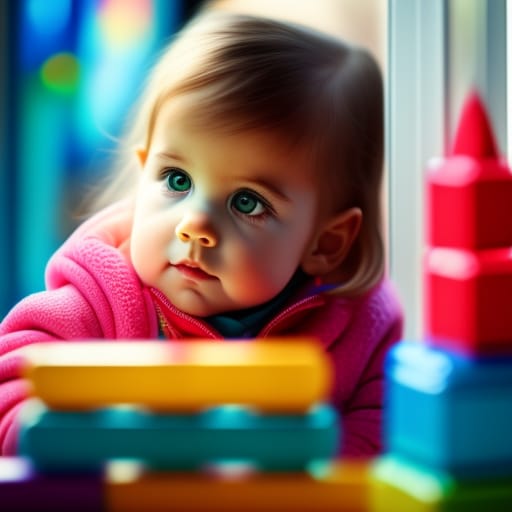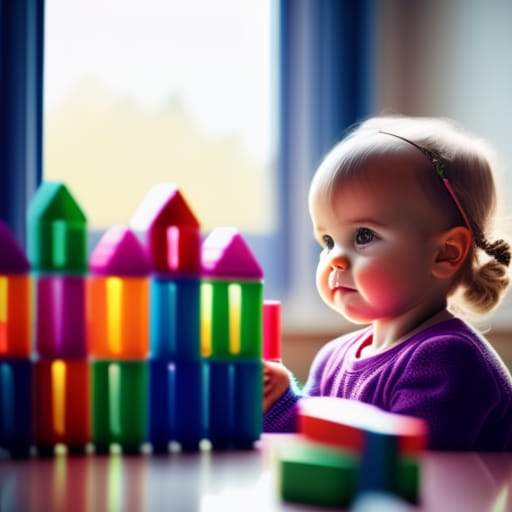Stacking blocks is a timeless activity that provides endless fun and important developmental benefits for kids. If you’re looking to introduce your child to block play, this comprehensive beginner’s guide will teach you everything you need to know.

An Introduction to Building Blocks
Building blocks are simple construction toys made of wooden, plastic, or foam materials that allow children to stack, balance, and create structures of varying complexity. Other names for these popular toys include wooden blocks, toy blocks, stacking blocks, and stacking toys.
Building blocks have been used as learning tools for children since the 1800s when German educator Friedrich Froebel created the first educational block set. He believed in the importance of play for childhood development and learning.
Today, stacking blocks remain a classic toy that teaches vital skills like hand-eye coordination, balance, spatial awareness, creativity, and problem-solving. Pediatricians and child development experts agree that block play provides key benefits for cognitive, motor, and social development in the early years.
In this guide, we’ll explore the many advantages of stacking blocks, how to choose the right set, popular block activities, and the best stacking block toys on the market. Let’s start by understanding why block play is so valuable for kids.
The Benefits of Playing with Stacking Blocks
It may look like just a silly game, but block play provides important developmental benefits for children of all ages. Here are some of the key reasons why stacking blocks is great for kids:
Enhances Motor Skills
- Fine motor skills: Precision needed to grasp and stack blocks and develop fine motor control.
- Hand-eye coordination: Stacking blocks strengthens hand-eye coordination as kids visually guide their movements.
- Balance: Balancing blocks on top of each other helps improve balance.
Fosters Spatial Skills
- Spatial awareness: Visualizing and manipulating 3D forms and structures boosts spatial reasoning.
- Gravity: Experimenting with gravity, balance, and stability with blocks teaches basic physics concepts.
- Architecture and engineering: Seeing how high they can stack blocks before toppling introduces kids to engineering principles.
Promotes Cognitive Abilities
- Creativity and imagination: Open-ended block play encourages kids to be creative and imaginative as they build.
- Critical thinking and problem-solving: Figuring out how to build sturdy structures involves logical thinking and problem-solving.
- Learning through play: Playing with blocks is an experiential way for kids to acquire knowledge and skills.
Provides Educational Value
- Valued in Montessori and Waldorf educational models that emphasize learning through play and hands-on activities.
- Considered an ideal early education STEM toy blocks can teach concepts related to math, engineering, and physics.
As you can see, what seems like simple fun with stacking blocks provides enormous developmental and educational benefits for young kids.
Types of Building Blocks for Kids
There are many types of stacking blocks and block sets designed for various ages and stages of development. Here are some of the most common options:
Wooden Blocks
- Classic, timeless material
- Often made of solid wood like pine, maple, beech, or birch
- Naturally smooth, durable, and eco-friendly
- Allows creativity in painting/decorating
- Can be expensive; prices range widely
Plastic Blocks
- Typically made of ABS plastic
- Very affordable option
- Often bright colors attractive to younger kids
- Lighter than wood; good for small hands
- Can have rounded edges for safety
- Not as eco-friendly as wood
Foam Blocks
- Lightweight foam material
- Soft texture safe for infants
- Often have tactile elements like numbers and letters
- Easy to clean and sanitary
- Less durable than wood or plastic
Magnetic Blocks
- Blocks with embedded magnets
- Allows building vertically and angled structures
- Promotes STEM learning
- Magnets can be a safety hazard if swallowed
In addition to basic block sets, there are also specialty stacking toys like Jenga or tumbling tower games that add a fun, skill-building element.
How to Choose the Right Stacking Blocks
With so many types and brands of stacking blocks available, it can be tricky to select the right set. Here are some tips for choosing age-appropriate blocks:
- Age range – Check the manufacturer’s recommended age range and select blocks suitable for the child’s developmental stage.
- Safety – For toddlers under 3, avoid small pieces or blocks with magnets which can be choking hazards.
- Eco-friendly – Look for blocks made from sustainable or non-toxic materials if this is a priority.
- A number of pieces – Start with around 30-50 pieces; add more as kids’ skills progress.
- Durability – Well-made wooden or plastic blocks will last for generations.
- Made in USA – Domestically manufactured blocks adhere to strict safety standards.
- Price – Sets can range from $15 for basic plastic blocks to $100+ for intricate wooden sets.
- Fun factor – Consider your child’s interests; add themed blocks or games to engage them.
Choosing quality stacking blocks made to last provides great value over cheap blocks that break easily. Investing in a set they’ll love playing with for years is worth the extra cost upfront.

Fun Ways to Play with Blocks
Once you’ve got a set of stacking blocks, the real fun begins! Here are some creative block play activities to try:
Build Towers
- See how high your child can stack blocks before toppling down.
- Add gentle challenges like stacking with just one hand.
- Transform it into a racing game to see who can build the tallest tower fastest.
Freeform Building
- Without specific instructions, allow your child to create whatever they imagine using blocks.
- Ask them to describe their process and what they are making.
- Display your child’s unique block creations like art.
Themed Building
- Build specific structures like castles, bridges, houses or garages using blocks.
- Recreate famous buildings and landmarks.
- Use toy cars, animals and people to populate the block world.
Games
- Line up towers like dominoes or bowling pins to knock down.
- Play classic block games like Jenga requiring balance and steady hands.
- Make a ball run using blocks as a chute or maze the ball rolls down.
For Therapy
- Occupational therapists often use block play to improve coordination and skills.
- Adjust challenges to work on weaknesses and developmental delays.
The possibilities are endless when stacking blocks! Let your child’s creativity and interests guide their play.
Top Block Sets and Brands
With so many stacking block options on the market, here are 10 of the best-selling and highest-rated sets:
| Product | Description | Price |
|---|---|---|
| Melissa & Doug Wooden Building Blocks | 100+ solid wood blocks in shapes/colors | $$ |
| Hape Quadro Wooden Building Blocks | 60 pieces of smooth, solid beech wood | $$$ |
| Playgro Color Blocks | Plastic; bright colors; chunky for small hands | $ |
| Magna-tiles Clear Colors | Transparent magnetic building blocks | $$ |
| Edushape Rainbow Blocks | 30 colorful, lightweight foam blocks | $ |
| Grimm’s Large Wooden Blocks | Extra-large carved maple blocks | $$$ |
| Lauri Toys Magnetic Blocks | 100+ magnetized building pieces | $$ |
| Guidecraft Giant Wooden Blocks | Oversized blocks for easier grasping | $$ |
| Jenga Classic Game | Wood block stacking game; ages 6+ | $ |
| HABA Wooden Rainbow Blocks | Colorful beech wood blocks with storage bag | $$ |
I recommend reading parent reviews and consumer reports to identify quality block sets that will last and keep kids engaged. Many appear consistently across “best blocks” lists year after year due to their enduring play value.
The Bottom Line
Playing with stacking blocks is far more than just child’s play. The simple act of building with blocks provides immense developmental and educational benefits for kids of all ages. With so many options available, choose blocks tailored to your child’s interests and abilities. Quality wooden or plastic block sets encourage open-ended play and creativity. Add specialty blocks like magnet tiles or games as kids’ skills progress. Investing in an engaging set of blocks can pay off for years of learning through hands-on play.

More Resources on Block Play
To learn more about the benefits of block play and discover activity ideas, check out these helpful resources:
NAEYC: Block Play Supports Early Learning
AAP: Blocks are Best for Baby Brains
PBS Parents: Why Build with Blocks
Childhood 101: Sensory Block Play Activities
The Genius of Play: Blocks are the Best Toy
Frequently Asked Questions
What are the benefits of stacking blocks?
Stacking blocks provides many developmental and educational benefits for children. Key benefits include improving fine motor skills, hand-eye coordination, balance, spatial awareness, creativity, critical thinking, and problem-solving skills. Pediatricians recommend block play to build skills in STEM (science, technology, engineering, math), literacy, and more through hands-on learning.
What are the best stacking blocks for toddlers?
Choose lightweight, large wooden blocks or soft foam blocks with rounded edges for toddlers under 3. Avoid small pieces that could pose a choking hazard. Colorful, chunky plastic blocks are also great for little hands. Select blocks in simple shapes, colors, and patterns to engage young children.
Is Jenga an educational game?
Yes, the classic block stacking game Jenga enhances hand-eye coordination, balance, precision, and problem-solving abilities. To be successful, kids must strategize, visualize spatial relationships, and exhibit control and patience. It’s a fun, interactive game with many cognitive benefits beyond entertainment.
How do I teach my child to build towers with blocks?
Start by demonstrating how to stack blocks vertically to build a tower. Add simple challenges like using just one hand or racing to build the tallest tower. Encourage them when towers topple so they keep trying. Stacking blocks teaches trial-and-error in a hands-on way. Kids will get the hang of it quickly with practice.
Are wooden or plastic blocks better?
Both classic wooden blocks and plastic blocks have benefits. Wooden blocks are more eco-friendly, often safer with rounded edges, and develop fine motor skills. Plastic blocks are very affordable, lightweight for small hands, and easy to sanitize. Choose blocks that are durable, non-toxic, and tailored for your child’s age and motor abilities.